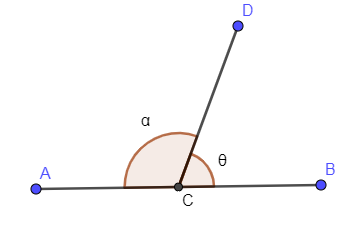Answer
424.5k+ views
Hint: We know that supplementary of any angle is the subtraction of that angle from ${{180}^{\circ }}$. So, in this problem we have given an angle of ${{40}^{\circ }}$so its supplementary angle is calculated by subtracting ${{40}^{\circ }}$from ${{180}^{\circ }}$. The result of this subtraction is the supplementary angle that we are looking for.
Complete step by step answer:
In the above problem, we are asked to find the supplementary angle of ${{40}^{\circ }}$.
The supplementary angle of any angle is equal to the subtraction of that angle from ${{180}^{\circ }}$.
Let us assume angle $\theta $ is the angle with respect to which we have to find the supplementary angle and the supplementary angle be $\alpha $.
In the below diagram, we have shown a straight line along with the angle $\theta $ and angle $\alpha $.

As you can see that $\theta \And \alpha $ are forming the linear pairs so the summation of both these angles is equal to ${{180}^{\circ }}$.
Adding $\theta \And \alpha $ and equating it to ${{180}^{\circ }}$ we get,
$\begin{align}
& \theta +\alpha ={{180}^{\circ }} \\
& \Rightarrow \alpha ={{180}^{\circ }}-\theta ......Eq.(1) \\
\end{align}$
Now, we have assumed that $\alpha $ is the supplementary angle of $\theta $.
In the above question, we are asked to find the supplementary angle of ${{40}^{\circ }}$ so from the above description of supplementary angle, $\theta ={{40}^{\circ }}$ so substituting this value of $\theta $ in eq. (1) we will get the value of supplementary angle corresponding to ${{40}^{\circ }}$.
$\begin{align}
& \alpha ={{180}^{\circ }}-\theta \\
& \Rightarrow \alpha ={{180}^{\circ }}-{{40}^{\circ }} \\
& \Rightarrow \alpha ={{140}^{\circ }} \\
\end{align}$
Hence, we have found the supplementary angle of ${{40}^{\circ }}$ as ${{140}^{\circ }}$.
Note: You can cross check the value of supplementary angle of ${{40}^{\circ }}$ that we have calculated above by using the relation that sum of the angle and its supplement is ${{180}^{\circ }}$.
The angle is ${{40}^{\circ }}$ and its supplementary that we have calculated above is ${{140}^{\circ }}$. Now, the addition of these two angles must be equal to ${{180}^{\circ }}$.
${{40}^{\circ }}+{{140}^{\circ }}={{180}^{\circ }}$
Adding the left hand side of the above equation we get,
${{180}^{\circ }}={{180}^{\circ }}$
As you can see that L.H.S = R.H.S so the supplementary angle that we have calculated above is correct.
Complete step by step answer:
In the above problem, we are asked to find the supplementary angle of ${{40}^{\circ }}$.
The supplementary angle of any angle is equal to the subtraction of that angle from ${{180}^{\circ }}$.
Let us assume angle $\theta $ is the angle with respect to which we have to find the supplementary angle and the supplementary angle be $\alpha $.
In the below diagram, we have shown a straight line along with the angle $\theta $ and angle $\alpha $.

As you can see that $\theta \And \alpha $ are forming the linear pairs so the summation of both these angles is equal to ${{180}^{\circ }}$.
Adding $\theta \And \alpha $ and equating it to ${{180}^{\circ }}$ we get,
$\begin{align}
& \theta +\alpha ={{180}^{\circ }} \\
& \Rightarrow \alpha ={{180}^{\circ }}-\theta ......Eq.(1) \\
\end{align}$
Now, we have assumed that $\alpha $ is the supplementary angle of $\theta $.
In the above question, we are asked to find the supplementary angle of ${{40}^{\circ }}$ so from the above description of supplementary angle, $\theta ={{40}^{\circ }}$ so substituting this value of $\theta $ in eq. (1) we will get the value of supplementary angle corresponding to ${{40}^{\circ }}$.
$\begin{align}
& \alpha ={{180}^{\circ }}-\theta \\
& \Rightarrow \alpha ={{180}^{\circ }}-{{40}^{\circ }} \\
& \Rightarrow \alpha ={{140}^{\circ }} \\
\end{align}$
Hence, we have found the supplementary angle of ${{40}^{\circ }}$ as ${{140}^{\circ }}$.
Note: You can cross check the value of supplementary angle of ${{40}^{\circ }}$ that we have calculated above by using the relation that sum of the angle and its supplement is ${{180}^{\circ }}$.
The angle is ${{40}^{\circ }}$ and its supplementary that we have calculated above is ${{140}^{\circ }}$. Now, the addition of these two angles must be equal to ${{180}^{\circ }}$.
${{40}^{\circ }}+{{140}^{\circ }}={{180}^{\circ }}$
Adding the left hand side of the above equation we get,
${{180}^{\circ }}={{180}^{\circ }}$
As you can see that L.H.S = R.H.S so the supplementary angle that we have calculated above is correct.
Recently Updated Pages
How many sigma and pi bonds are present in HCequiv class 11 chemistry CBSE

Why Are Noble Gases NonReactive class 11 chemistry CBSE

Let X and Y be the sets of all positive divisors of class 11 maths CBSE

Let x and y be 2 real numbers which satisfy the equations class 11 maths CBSE

Let x 4log 2sqrt 9k 1 + 7 and y dfrac132log 2sqrt5 class 11 maths CBSE

Let x22ax+b20 and x22bx+a20 be two equations Then the class 11 maths CBSE

Trending doubts
Fill the blanks with the suitable prepositions 1 The class 9 english CBSE

At which age domestication of animals started A Neolithic class 11 social science CBSE

Which are the Top 10 Largest Countries of the World?

Give 10 examples for herbs , shrubs , climbers , creepers

Difference between Prokaryotic cell and Eukaryotic class 11 biology CBSE

Difference Between Plant Cell and Animal Cell

Write a letter to the principal requesting him to grant class 10 english CBSE

Change the following sentences into negative and interrogative class 10 english CBSE

Fill in the blanks A 1 lakh ten thousand B 1 million class 9 maths CBSE



